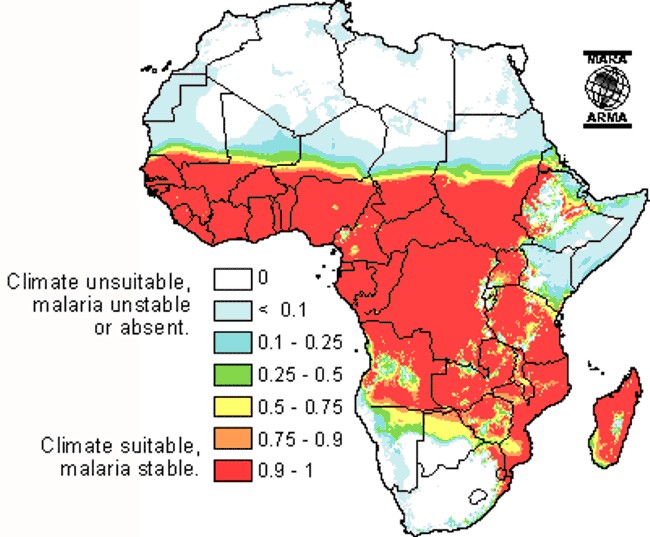This map shows the distribution of malaria in Africa. It is not based on malaria data, but is produced using a rules based model based on climatic data.
The rules used are:
- Parasite (Plasmodium)development doesn't happen below 16oC;
- transmission of malaria is unlikely if the temperature is below 18o C because very few adult mosquitoes survive the 56 days required for the sporogonic cycle at that temperature;
- At 22oC the transmission cycle can be completed as the sporogonic cycle takes less than 3 weeks and the mosquito survival rate is high enough (15%);
- If the temperature is above 32oC the mosquito mortality rate is high;
- The mosquitoes can't survive above 40oC;
- 80mm of rain per month is suitable;
- 0mm rain per month is unsuitable;
- The area needs to have no winter frost (frost eliminates mosquito populations).
The combination of all these factors was used to produce values which show how suitable an area is for malaria transmission, ranging from 0 (unsuitable) to 1 (suitable).
From this, it is easy to see how much more complex rules based models can be than simple statistical models. The rainfall and temperature have to be at the right levels, at the same time of year, to allow transmission. One without the other won't work.
In addition to this, they have to be at the right level for the right amount of time to allow the transmission cycle to be completed (see the biology pages for more details of this cycle). This length of time is also related to the balance between temperature and rainfall. In north Africa where it is hot, the rainfall season only needs to last for three months for the mosquito populations to grow big enough for transmission of malaria. Wherease in the cooler, southern African countries, the rainfall period needs to be 5 months. This is because the mosquito cycle is slower in cooler temperatures and faster in warmer temperatures.
This doesn't meant that areas with a stability rating of 0 will never have cases of malaria, occasional epidemics may still occur. Likewise, areas with a rating of 1 may still have fluctuations due to factors which aren't included in this model.
In fact, no models can be completely fool proof. This model was tested by comparing it with malaria data. The predictions of risk were very close to the actual reported cases. One area where the model was less succesful was that the data showed higher prevalence of malaria in the major river valleys in East Africa. This is becuase the model only used rainfall as an indication of water availability, however mosquitoes can survive along river banks where water is brought from other areas.
